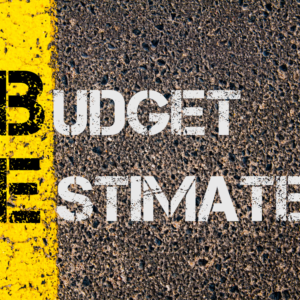1. Introduction to Budget Estimating
Budget estimating is the process of forecasting the financial resources needed to complete a project within its scope. It involves calculating costs for labor, materials, equipment, and other expenses that contribute to the final budget. This process is vital for project planning and resource allocation, setting clear expectations for stakeholders on what the project will require financially.

2. Importance of Budget Estimating
Effective budget estimating is essential for:
- Controlling Costs: Ensures projects do not exceed financial limits, saving both time and money.
- Managing Resources: Helps allocate materials, labor, and equipment efficiently.
- Reducing Risks: Identifies potential financial risks early, allowing for proactive solutions.
Proper budget estimation supports informed decision-making and minimizes the chances of project delays or cost overruns.
3. Key Types of Budget Estimates
There are several types of budget estimates used at various stages:
- Preliminary Estimate: An early, rough estimate based on limited data, often used in the feasibility stage.
- Detailed Estimate: A more precise forecast based on detailed project plans and data.
- Final Estimate: The definitive estimate prepared just before the project begins.
- Control Estimate: Used throughout the project to monitor costs and guide spending.
Each type serves a specific purpose, evolving as the project progresses from initial concept to execution.
4. Components of a Budget Estimate
A comprehensive budget estimate typically includes:
- Direct Costs: Costs directly tied to the project, such as labor, materials, and equipment.
- Indirect Costs: Overhead costs, including administrative and supervisory expenses.
- Contingency: A buffer to cover unexpected costs, mitigating risks.
- Overhead and Profit: Costs associated with operating expenses and contractor margins.
Including these components creates a realistic budget that considers all potential financial aspects of the project.
5. Budget Estimating Techniques
There are several methods to create a budget estimate:
- Analogous Estimating: Uses data from similar past projects to predict costs.
- Parametric Estimating: Applies mathematical models, often per unit, like cost per square foot.
- Three-Point Estimating: Averages three scenarios (optimistic, pessimistic, and most likely) for a balanced estimate.
- Bottom-Up Estimating: Breaks down costs for each task or element, building up to a total estimate.
Each technique has its strengths and is chosen based on project requirements, available data, and accuracy needs.
6. Steps in Creating a Budget Estimate
The budget estimating process includes:
- Defining Project Scope: Establishing clear objectives and deliverables.
- Data Collection: Gathering data on costs, materials, labor rates, and more.
- Cost Analysis: Selecting an estimation method and applying it to determine costs.
- Final Estimate Development: Compiling the estimate into a comprehensive budget document.
Following these steps ensures the budget estimate is well-structured, transparent, and accessible for project stakeholders.
7. Tools and Software for Budget Estimating
Popular tools for budget estimating include:
- ProEst: Known for advanced reporting and integration with project management platforms.
- Sage Estimating: Offers comprehensive takeoff and estimating capabilities.
- Microsoft Project: Provides budget tracking and integrates well with scheduling tools.
These tools streamline estimation, making it faster and more accurate by automating calculations and data management.
8. Best Practices for Accurate Budget Estimating
To improve budget estimating:
- Regular Revisions: Update estimates as new data becomes available or project details change.
- Collaborative Planning: Involve stakeholders to ensure accuracy and account for all perspectives.
- Attention to Detail: Ensure all aspects of the project are included in the budget estimate, avoiding general assumptions.
Adopting these practices helps create a reliable budget, ensuring projects stay financially on track.
9. Role of Budget Estimating in Project Lifecycle
Budget estimating plays a vital role across all project stages:
- Planning: Establishes a financial foundation, guiding the initial project direction.
- Execution: Helps track actual costs against the budget, allowing for adjustments.
- Monitoring and Controlling: Enables regular cost checks and adjustments to prevent overspending.
In each phase, budget estimation acts as a financial compass, keeping the project aligned with its financial goals.
10. Common Challenges in Budget Estimating
Estimators face various challenges, such as:
- Market Fluctuations: Material and labor prices may change unexpectedly.
- Data Uncertainty: Incomplete or inaccurate data can result in flawed estimates.
- Scope Changes: Alterations to project scope often require estimate revisions.
Overcoming these challenges requires adaptability, thorough data collection, and open communication with project teams.
11. The Importance of Contingency in Budget Estimating
Contingency is crucial because:
- It Manages Uncertainty: Acts as a safety net for unforeseen expenses.
- Prevents Shortfalls: Ensures funds are available to cover potential cost increases.
- Supports Flexibility: Allows adjustments for unexpected changes in the project’s scope or timeline.
Including a contingency reserve is a best practice that safeguards the budget, ensuring projects can handle unanticipated expenses.
12. Factors Influencing Budget Estimates
Numerous factors impact budget estimates, including:
- Location: Different regions have varying labor rates, material costs, and regulatory fees.
- Market Conditions: Economic conditions influence costs of resources, materials, and labor.
- Labor Costs: Project complexity, skilled labor demand, and market availability impact wages.
Recognizing these influences helps estimators make informed adjustments to budget estimates, increasing their accuracy.
13. Budget Estimating in Large vs. Small Projects
Large and small projects have unique budget estimating needs:
- Large Projects: Require detailed estimates, more contingency, and account for a wide range of variables.
- Small Projects: Typically have simpler requirements, fewer resources, and faster estimations.
Each project size requires a tailored approach, ensuring the budget is proportionate to the project’s scope and scale.
14. Future Trends in Budget Estimating
The future of budget estimating is shaped by:
- Artificial Intelligence (AI): Predicts costs using historical data and improves accuracy.
- Real-Time Data Integration: Allows continuous updates, enhancing decision-making.
- Predictive Analytics: Anticipates future cost trends and helps adjust budgets proactively.
These advancements make budget estimating more precise, efficient, and adaptable to changing project demands.
15. Frequently Asked Questions
- What is budget estimating?
- Budget estimating is the process of forecasting a project’s financial needs, including all resources and contingency funds.
- How does contingency impact budget estimating?
- Contingency provides a financial buffer, helping projects manage unexpected costs and prevent budget shortfalls
 .
.
- Contingency provides a financial buffer, helping projects manage unexpected costs and prevent budget shortfalls
- What is the best technique for budget estimating?
- The ideal technique depends on the project. Bottom-up estimating is highly accurate, while analogous estimating is useful for early project stages.
- How does market fluctuation affect budget estimates?
- Market changes impact material and labor prices, which can alter the final project cost. Including contingencies helps manage this risk.
- What role does budget estimating play in project planning?
- Budget estimating establishes the financial framework, guiding project scope, resources, and timelines.
- Can software improve budget estimating accuracy?
- Yes, software automates calculations, integrates real-time data, and streamlines budgeting, reducing human error. Vie More About Us.

